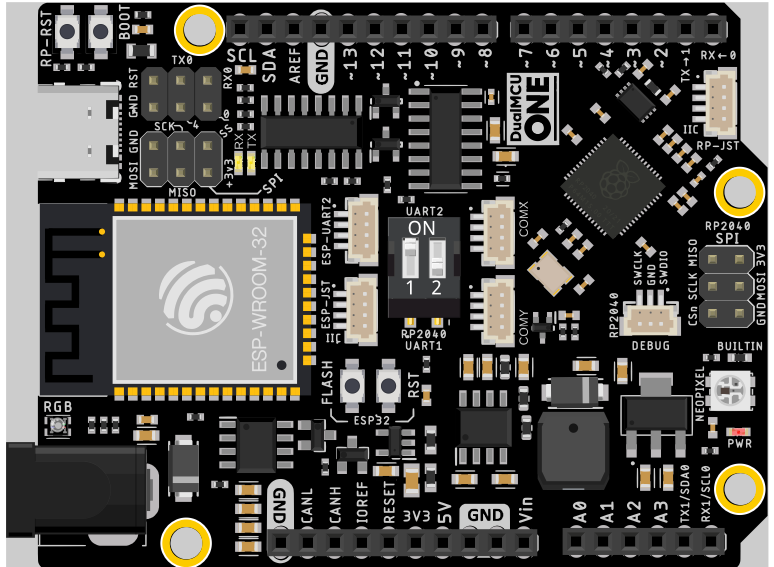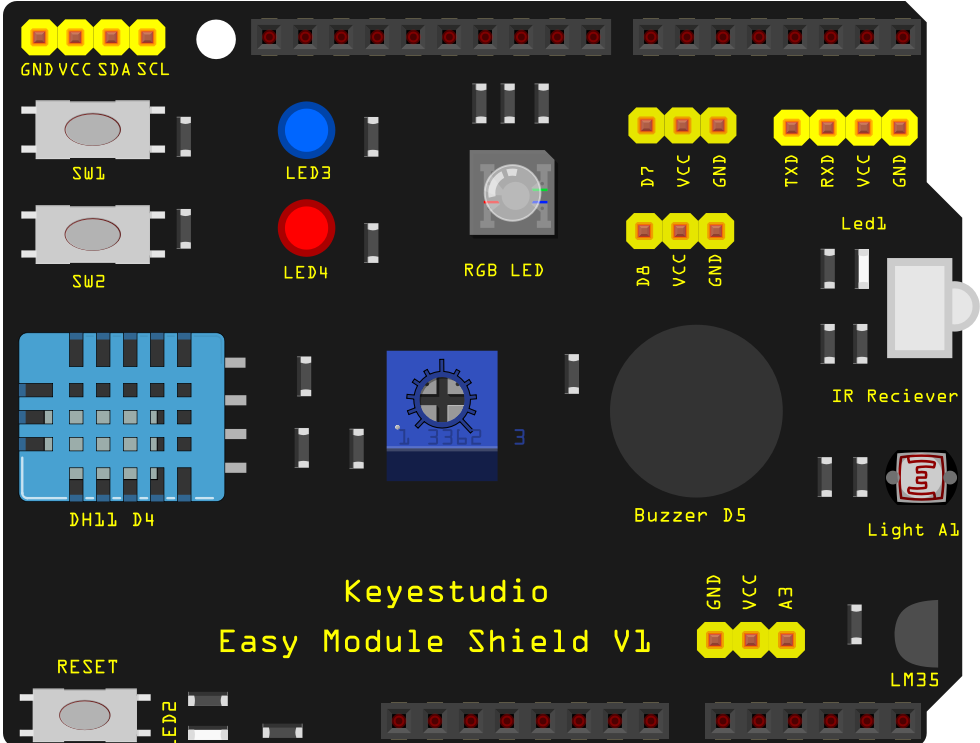Arduino Shields Compatibility#
The DualMCU ONE board is compatible with a wide range of Arduino shields and accessories. The board features the same pinout as the Arduino UNO Rev3, making it easy to use with existing shields. The board also features a USB-C connector for power and data, a microSD card slot, and a dual-core architecture with an RP2040 and an ESP32 microcontrollers.
Warning
The DualMCU ONE board is designed to be compatible with Arduino shields, but not all shields may work perfectly due to differences in voltage levels and pin configurations. Always check the specifications of the shield you are using to ensure compatibility.

Fig. 36 DualMCU ONE board#
Multi-purpose Shield for DualMCU ONE#

Fig. 37 Multi-purpose Shield#
The Multi-purpose Shield is a versatile accessory for the DualMCU ONE board. It features a variety of sensors and components, including:
2 LED indicators: Show the program status.
2 switches: For external interrupt experiments.
Reset button: Allows resetting the board.
DHT11 sensor: Measures temperature and humidity.
Potentiometer: Provides analog input.
Passive buzzer: Functions as an alarm.
Full-color RGB LED: Provides multiple color options.
Photocell: Detects the brightness of light.
LM35D temperature sensor: Measures temperature.
Infrared receiver: Enables infrared communication.
Digital pins: 2 digital pins (D7 and D8).
Analog pin: 1 analog pin (A3).
IIC interface: For I2C communication.
TTL serial pin: For serial communication.
Warning
The Multi-purpose Shield ADC sensors are connected to a 5V voltage supply, so caution is needed when connecting them to the DualMCU ONE board.
from machine import Pin
import time
from dht import DHT11
from dualmcu import *
# Create an instance of Shield
my_shield = Shield(
pin_red=D9, pin_green=D10, pin_blue=D11,
pin_buzzer=D5, pin_led1=D13, pin_led2=D12,
pin_button1=D2, pin_button2=D3, pin_analog=A0
)
# Configure DHT11 sensor
sensor_dht = DHT11(Pin(D4))
try:
while True:
# Read DHT11 sensor
sensor_dht.measure()
temp_dht = sensor_dht.temperature()
hum = sensor_dht.humidity()
# Read analog sensor
analog_value = my_shield.read_analog()
# Print the values read
print(f'Temperature: {temp_dht}°C Humidity: {hum}% Analog: {analog_value}')
# Read buttons and control LEDs
my_shield.set_led1(my_shield.read_button1() == 0)
my_shield.set_led2(my_shield.read_button2() == 0)
# Play a sequence of tones and change the LED colors
for color, freq in zip(
['red', 'green', 'blue', 'yellow', 'cyan', 'magenta', 'white', 'off'],
[262, 294, 330, 349, 392, 440, 494, 523]
):
my_shield.set_led(color)
my_shield.play_tone(freq, 0.5)
time.sleep(0.1)
except KeyboardInterrupt:
my_shield.deinit()
